Criminal Justice Reform Efforts and Rise in Crime: Conclusion
Summary
Over the last several months, we have evaluated the crime trends and criminal justice reform efforts in six Safety and Justice Challenge jurisdictions—Broward County, Clark County, City of St. Louis, Allegheny County, Baton Rouge and Missoula County—in response to the nation-wide rhetoric that reforms are causing a spike in crime. Readers learned about the sites’ six-year crime rates, their unique criminal justice reform efforts to reduce jail populations and whether the implementation of these efforts could be associated with an increase in crime.
Criminal justice reform levels and violent and property crime trends differed greatly among the six sites, but there were some consistencies and overarching trends. In evaluating the data, we conclude that there is likely no correlation between reforms and a rise in crime in these jurisdictions.
To read the entire series, you can access the introduction here.
Crime Trends
Almost every evaluated jurisdiction saw a decrease in overall property crimes over a six-year period. Only Clark County saw an increase, which was from 2020 to 2021, and still remained below the county’s six-year high.
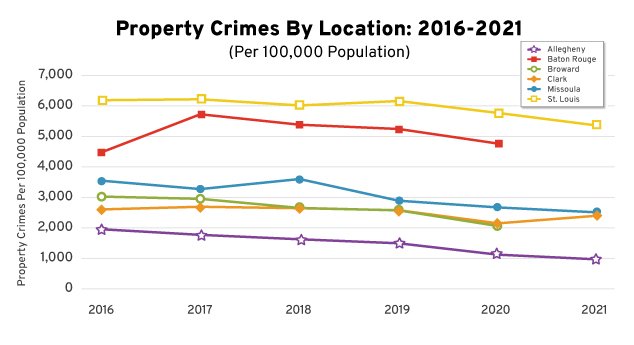
Every jurisdiction saw fairly significant decreases in burglaries, while motor vehicle thefts and larcenies were more inconsistent between the communities. The jurisdictional comparison of these property crime trends is shown below using data gathered during this series.
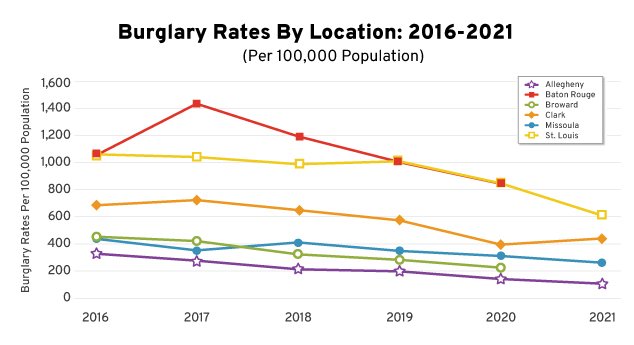
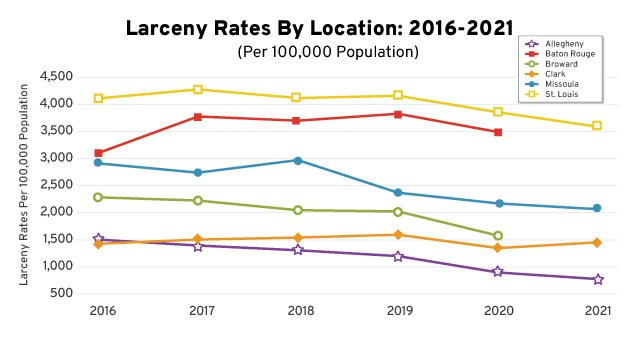
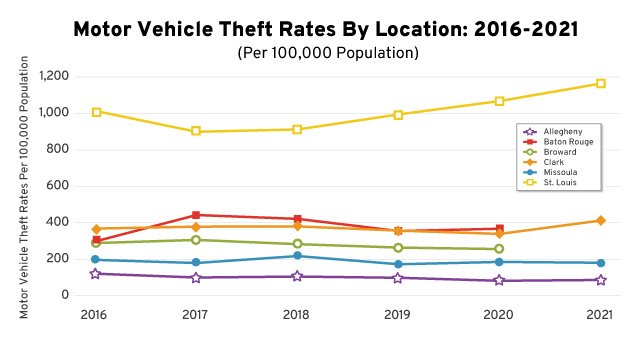
Overall violent crime trends were less consistent than the trends in property crimes. Clark County saw a significant decrease in violent crimes over the six-year period. Broward County, Allegheny County and the City of St. Louis also saw a decrease in violent crimes, but to a lesser extent. Baton Rouge and Missoula County both saw a slight increase in violent crimes during the six-year period.
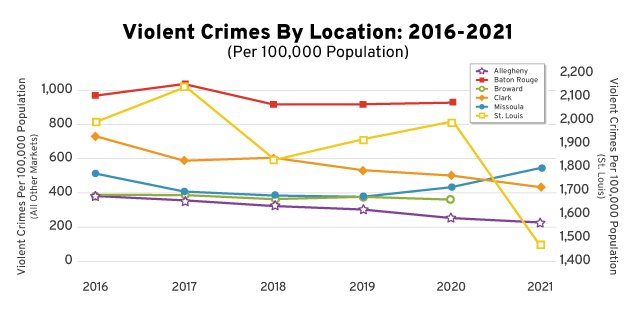
Rapes and robberies fell in every single jurisdiction during the six-year time period. Assaults decreased in three jurisdictions (Clark County, Allegheny County and the City of St. Louis) and increased in three jurisdictions (Broward County, Baton Rouge and Missoula County). Murder rates ebbed and flowed in the jurisdictions over the six-year period, however, every single jurisdiction saw an increase from 2019 to 2020. In fact, St. Louis saw its highest murder rate in 50 years and East Baton Rouge Parish—in which the City of Baton Rouge lies—saw its highest murder rate ever. Following 2020, some jurisdictions then saw a decrease into 2021. This includes a dramatic decrease in murders in St. Louis. The jurisdictional comparison of these violent crime trends is shown below using the data gathered during this series.
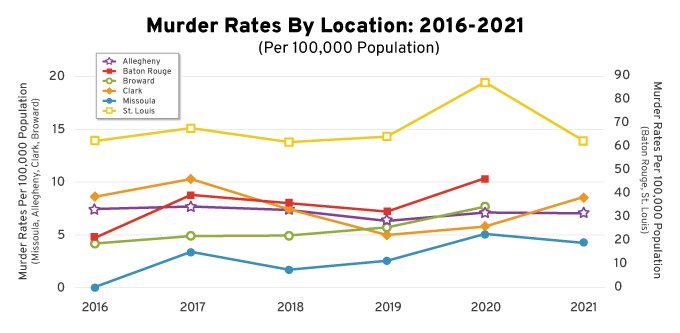
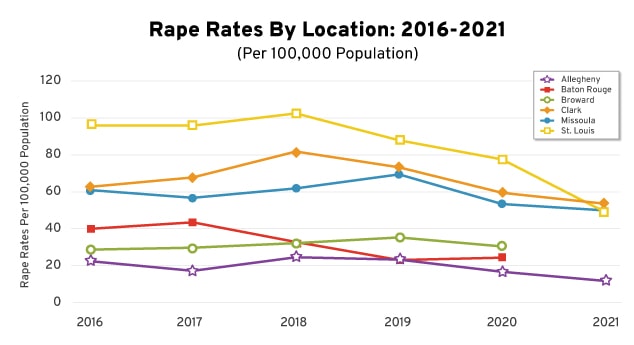
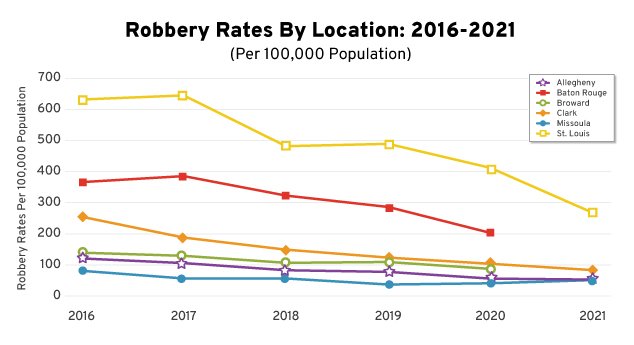
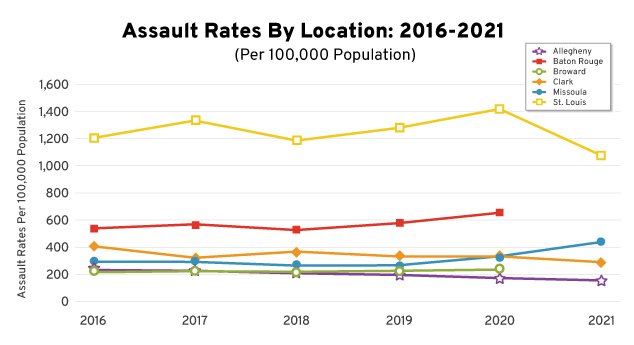
During the six-year period, all jurisdictions except for one—Missoula County—saw a decrease in jail populations. These trends, compiled from the Safety and Justice Challenge, are shown below.
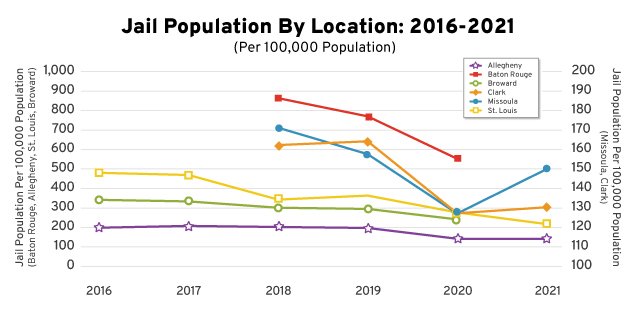
The increased use of electronic home monitors—which some see as a step between unsupervised release and jail—may have assisted in reducing jail populations. It is important, though, for jurisdictions to evaluate whether use of these monitors inadvertently included those that the court previously would have released on personal recognizance under lesser conditions. Notably, some being detained without bond may have been arrested for reasons other than a new offense—such as a parole violation or an out of state warrant—that are ineligible for bond, meaning the data may appear skewed.
Criminal Justice Reform Efforts
Between the jurisdictions, reform efforts to help reduce jail populations spanned from prearrest strategies to pretrial release to prosecutor-led tactics. Some of these reforms were implemented at a state level, while others were done locally.
Behavioral Health
One of the most notable trends was the effort to address mental health and substance abuse (i.e. behavioral health) concerns. Research shows that approximately 44 percent of those in jail have a mental illness and 63 percent have a substance use disorder. The last several years have seen a nationwide increase in mental health crisis and overdose deaths. Programs like the co-responder program in St. Louis; the community responder program in Missoula County; the police-led, prearrest diversion programs in Allegheny County; the Mental Health Court in Broward County; and the crisis stabilization center in Baton Rouge aim to address behavioral issues outside of the criminal justice system directly. These programs help deescalate crisis situations and connect individuals with ongoing resources. By doing so, these programs can reduce repeat calls and recidivism, thereby freeing up time for law enforcement to concentrate on more serious and complex crimes.
Improve Criminal Justice Process
Another notable trend was to make the criminal justice process more efficient. Nevada reduced the time before pretrial release hearings (anything done at the state level will affect the county); Baton Rouge developed a Rapid Case Assessment Team; Missoula County improved case processing; and St. Louis dismissed several, years-old cases that had been “taken under advisement” with no formal charges. While cases can be pending in the criminal justice system for months if not years, research shows one of the most effective deterrents for crime is how swiftly a punishment is implemented. Indeed, some suggest that court closures in response to COVID-19 caused the rise in crime following the onset of the pandemic. Further, the aftermath of a large backlog of cases has added pressure on courts and prosecutors to dispose of cases to relieve overcrowded jails and to not run afoul of an individual’s right to a speedy trial. These reforms create a more efficient process, aiming to hold individuals accountable more quickly and fairly in order to reduce future criminal behavior while also better protecting constitutional rights.
Alternatives to Arrest
Finally, several jurisdictions implemented alternatives to arrest. This includes Nevada’s mandatory criminal citation for certain offenses; Broward County’s civil citation authority; and St. Louis’ prosecutorial policy to issue summons. Issuing a citation or summons in lieu of arrest can save taxpayer dollars and free up law enforcement time, which has become even more important as agencies face staffing shortages. Further, cited individuals can avoid the negative impacts and collateral consequences—such as loss of a job or housing—of incarceration, thereby reducing the chance of recidivism.
Conclusion
Based on the reviewed crime trends and criminal justice reform efforts within each jurisdiction, we did not find evidence of a correlation between reforms and a rise in crime. However, in analyzing the data, we identified several opportunities and challenges.
While most communities publicly publish crime statistics, some communities were more than a year behind in releasing their county-wide data. In one jurisdiction—East Baton Rouge Parish—only the crime statistics for the county seat were readily available and easily accessible to the public. Further, many communities only had data on crime statistics. Data on whether individuals committing new crimes were out on pretrial release, diversion or probation, or impacted by any other reform initiative appeared obsolete. In order to ascertain whether reforms had any notable impact on a rise in crime, it is necessary to analyze this additional information. Jurisdictions could benefit from making their data collection more robust, timely and publicly available. Additionally, there are concerns of an increase in gun violence across the nation, but few jurisdictions publish this data.
From the data that was available, the increase in homicides, assaults and motor vehicle thefts across several of the jurisdictions is concerning. These specific crimes, however, have increased on average across the nation following the onset of the COVID-19 pandemic and the discourse after the murder of George Floyd. This suggests a nationwide factor is contributing to the increase in these crimes, rather than local efforts. This is further supported by the fact that none of the reforms implemented were applicable to individuals accused of violent crimes. Notably, most of the jurisdictions with published crime statistics saw a decrease in murders and assaults from 2020 to 2021.
Even more promising was the significant decline in robberies, rapes and burglaries across the jurisdictions during the six-year period—yet jurisdictions did not appear to be sharing or promoting this achievement. Promotion of this reduction in several specific crimes could help rebut the perception of a universal increase in crime overwhelming criminal justice discussions. This could also lend credibility to current reforms and provide data for further political and financial support of such efforts.
Similarly, jurisdictions could also benefit from increasing the promotion and expanding the use of successfully implemented reforms. Some reform efforts had limited information publicly available. This leads to questions of whether such programs are being properly shared with partners, fully utilized and/or fully evaluated. Transparency, cross-promotion, consistent evaluation and growth (if appropriate) of such efforts could prove valuable for a larger positive impact in local communities.
This series explored several innovative criminal justice reform efforts, many of which show positive results and none of which show a corresponding increase in crime. Other jurisdictions could benefit from these findings by implementing similar reforms or conducting further analysis on their own jurisdiction. Ultimately, safe and smart criminal justice reforms can help jurisdictions save taxpayer dollars, uphold individual freedoms and increase public safety.
- Criminal Justice Reform Efforts and Rise in Crime: Introduction
- Criminal Justice Reform Efforts and Rise in Crime: Spotlight on Broward County, Fla.
- Criminal Justice Reform Efforts and Rise in Crime: Spotlight on Clark County, Nev.
- Criminal Justice Reform Efforts and Rise in Crime: Spotlight on City of St. Louis, Mo.
- Criminal Justice Reform Efforts and Rise in Crime: Spotlight on Allegheny County, Pa.
- Criminal Justice Reform Efforts and Rise in Crime: Spotlight on Baton Rouge, La.
- Criminal Justice Reform Efforts and Rise in Crime: Spotlight on Missoula, Mont.
- Criminal Justice Reform Efforts and Rise in Crime: Conclusion







